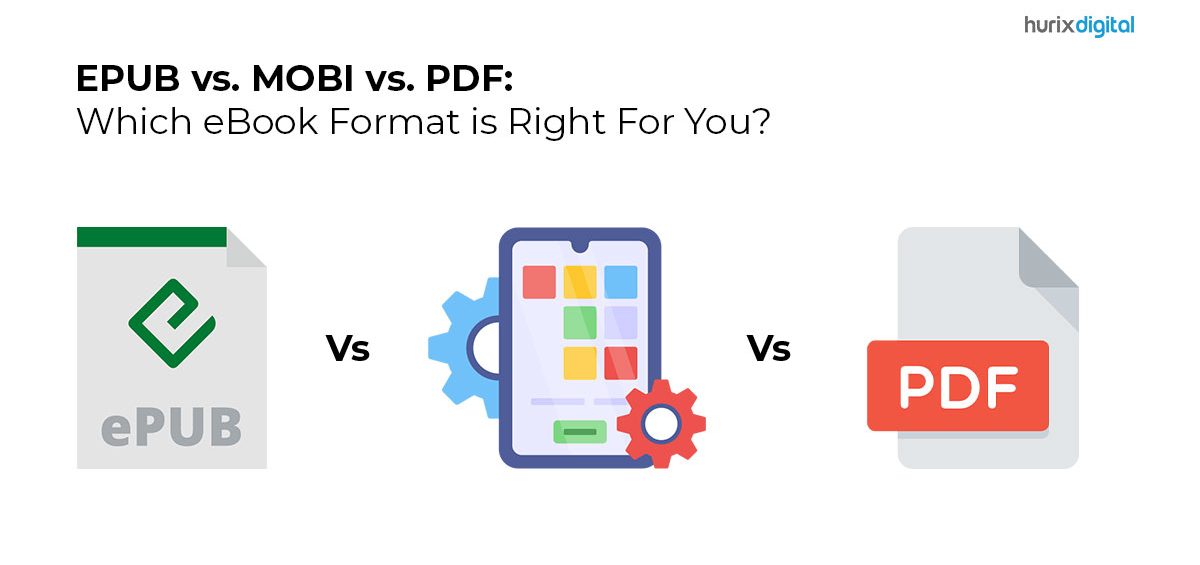Summary
This blog has helped you understand the different eBook formats and helped you decide which one is the right one for you.
So, you have your magnum opus ready for publishing. In this age of ebooks, the next big decision is which format to publish in. While on the surface, it may seem like an easy decision to choose one among the three, there are many finer details to consider before doing so.
In this blog, we will compare the three most popular ebook formats of today and help you get answers to several questions that may be racing across your mind, such as “Should I convert my ebook from EPUB to PDF?”, “How do I choose between EPUB or MOBI?” or “What is the difference between EPUB and PDF?” and so on.
Table of Contents:
- A Brief History of Ebook Formats
- What To Look For In An eBook Format?
- EPUB vs. MOBI vs. PDF
- Summing Up
A Brief History of Ebook Formats
Contrary to popular belief, the concept of an e-reader was envisioned nearly a century ago. In his manifesto named “The Readies,” an American writer named Bob Brown envisioned a device that he predicted would be the future of reading.
His prediction is the ability to read a book off a screen rather than a piece of paper. This was back in 1930.
Fast forward to 1993, Adobe Systems created the Portable Document Format (PDF). Designed to share documents digitally across various platforms and applications, it is by far the most commonly used format for sharing digital documents today.
In 2000, a French company named Mobipocket developed the MOBI Format, an extension of the Open eBook format (OEB). As the name implies, this format was specifically designed for reading ebooks on mobile devices of that era, PDAs, and the very first smartphones.
When the tech giant Amazon bought Mobipocket in 2005, it used its technology to create the AZW format for its Kindle devices.
The EPUB format is the new kid on the block. It was created in 2007 by the International Digital Publishing Forum (IDPF). Today, it is the most commonly used format for ebooks. This is because it is based on XML and HTML standards, making it compatible with most e-reader devices and software today.
There is no doubt that ebooks are here to stay. Revenues in the eBook market space are projected to hit $14 billion by the end of 2023, which makes it paramount to choose the best format for your specific needs.
What to Look for in an eBook Format?
To determine which ebook format works best for specific applications, it is essential to be aware of all the factors one must consider when doing so. Here are some of the primary factors to take into consideration:
1. The Target Audience
Your target audience plays a major role in deciding which eBook format to go for. If your ebook is for the masses, then your priority should be a format compatible with as many devices or platforms as possible.
This scenario will call for a comparison of EPUB vs. PDF formats. If you are targeting a specific niche, do your due diligence to determine which format is prevalent in those circles.
2. The Content of Your eBook
Not all eBook formats are made the same. Some handle text better, while others can support audio, video, and other interactive elements.
PDF files preserve a document’s layout, fonts, and graphics, which can be a critical factor for technical ebooks, while EPUB is better at reflowing to fit the content better based on the device.
3. Security
Unauthorized use and distribution is another factor to consider.
The PDF format reigns supreme as it supports encryption and password protection. MOBI, too, supports DRM to protect itself against plagiarism. Being an open format, EPUB is the least secure of the three.
Also Read: EPUB Conversion Service to Fit Your Content Conversion Needs
EPUB vs. MOBI vs. PDF
Now that you know what to look for, let’s look at the three formats individually.
EPUB
Today, EPUB is the most popular ebook format in use. The most significant difference between epub and pdf is that epub is open source. As a dedicated ebook format, it does offer a few advantages over the other formats mentioned here.
The Pros of The EPUB Format:
- EPUB is an open and standard format widely supported by various devices and software. The list also finally includes Amazon’s Kindle.
- EPUB is a reflowable format that can adapt to various screen sizes and orientations, making it more user-friendly and accessible.
- EPUB can support multimedia and interactive elements, such as color images, SVG graphics, audio, video, animations, etc.
- If required, it can also be easily converted to other formats.
Drawbacks
While the EPUB format does have its advantages, there are a few things to know that don’t work in its favor. They are:
- If your ebook is going to need a complex format or needs to retain its original layout, then this is not the suitable format for it.
- It is not as secure as the PDF format. While this format does support DRM, unfortunately, it is very easy to circumvent or remove it.
MOBI
Amazon primarily used the MOBI format for its Kindle devices, but as of August 2022, the company stopped using this format. While existing eBooks with this format will not be affected, they can be converted to epub or PDF formats. In short, this file format is no longer relevant in 2023.
PDFs
As mentioned in the previous section, the PDF format was designed and developed to create virtual documents. So, while it is not a dedicated ebook format, it can be considered the jack of all trades.
When to Choose the PDF Format?
The following scenarios are when the PDF format will work best for you:
- If your ebook requires a format that supports a complex layout and is fixed so that the design remains the same across all devices.
- Suppose security is your primary concern. The PDF format offers the most robust security.
- If you want maximum compatibility, PDFs are the most popular document formats today, and almost every device has support for it.
Drawbacks
PDF files, once saved, are not editable unless you have the right software to do so. PDF files are generally large, which can be a deterrent when sharing them online or when it comes to storage.
They are not easy to convert to other formats. While you may find plenty of tools to convert EPUB to PDF online, you will not find any tools that can convert pdf to other formats(those that work well).
Also Read: Why Do Authors Need a Professional ePub Conversion Service?
Summing Up
In the world of eBook formats, your choice is your compass. EPUB, the versatile virtuoso, works well on devices. PDF ensures that your layout remains intact. MOBI, popular, has now given way to newer options. Your content and your target audience should be your deciding factors.
Do you have content you want to be converted from PDF to ePub? If so, Hurix Digital can help you do just that. We offer various editorial and pre-press services, including copyediting, typesetting, artwork, design, and XML conversion. Our team of experts has the experience and technology to deliver high-quality and cost-effective solutions for publishers of all sizes.
Contact us today to learn more about how we can help you take your content to the next level.







